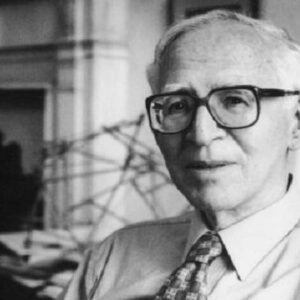Aaron Klug, a Nobel Laureate in Chemistry, requires no introduction. He is credited with inventing crystallographic electron microscopy. His method of transforming a two-dimensional image into a three-dimensional image has been used in a variety of fields, the most renowned of which being the CT scan. He was born to Jewish parents in Zel’va, Biaystok Voivodeship, and migrated to South Africa with his family when he was two years old. He was always interested in science and earned a Bachelor of Science degree from the University of the Witwatersrand before going on to get his Master of Science degree at the University of Cape Town. He eventually relocated to England, where he received his PhD from Trinity College, Cambridge. He began working with Rosalind Franklin in John Bernal’s lab at the University of London’s Birkbeck College. This sparked a lifelong fascination in viruses in him. Klug went on to examine helical viruses to learn how protein units are generated, work with J. D. Bernal on the polio virus, and investigate the structure and function of transfer DNA (deoxyribonucleic acid). He was a well-known chemist who was honored for his contributions to crystallographic electron microscopy and the structural elucidation of biologically significant nucleic acid-protein complexes.
Childhood and Adolescence
Aaron Klug was born to Jewish parents Lazar and Bella on August 11, 1926 in Zel’va, Biaystok Voivodeship, Republic of Poland. His father was a cattleman who had received saddler training. He used to write newspaper pieces as well. When Aaron was a toddler, the family relocated to South Africa.
He went to Durban High School and read Paul de Kruif’s book “Microbe Hunters,” which encouraged his interest in microbiology. He attended the University of the Witwatersrand after high school and received a Bachelor of Science degree. He subsequently went to the University of Cape Town to pursue his Master of Science degree.
He was an excellent student, and the Royal Commission for the Exhibition of 1851 granted him a Research Fellowship in 1851. On the basis of this scholarship, he travelled to England and finished his PhD at Trinity College, Cambridge, in 1953.
Career of Aaron Klug
In late 1953, he traveled to Birkbeck College at the University of London and began working with Rosalind Franklin in John Bernal’s viral lab. He made significant contributions to the structure of the tobacco mosaic virus in the lab.
He created his own crystallographic electron microscopy techniques, in which a sequence of electron micrographs of two-dimensional crystals obtained from various angles are merged to create three-dimensional images of particles.
Aaron Klug became the director of Birkbeck’s Virus Structure Research Group in 1958. In 1962, he returned to Cambridge as a member of the Medical Research Council’s staff after serving there for four years.
He spent the next decade developing crystallographic electron microscopy, which combines a series of two-dimensional images of crystals obtained from various angles to construct three-dimensional views of the target, combining techniques from X-ray diffraction, microscopy, and structural modeling.
Later, he worked on revealing the structure of chromatin, a DNA-protein complex. Klug and his associates were the first to collect transfer RNA crystals and establish their structure in 1974.
Major Projects of Aaron Klug
Aaron Klug is most known for his work on electron crystallography, which uses a transmission electron microscope to identify the arrangement of atoms in crystals (TEM). In 1978, he used high-resolution electron microscopy (HREM) to conduct electron crystallographic research on inorganic crystals.
Achievements and Awards
Klug received the Louisa Gross Horwitz Prize from Columbia University in 1981.
In 1982, Klug received the Nobel Prize in Chemistry for his contributions in crystallographic electron microscopy.
He was the director of the Laboratory of Molecular Biology in Cambridge from 1986 until 1996.
Klug was knighted by Elizabeth II in 1988.
He served as President of the Royal Society from 1995 to 2000. He was also a member of The Scripps Research Institute’s Board of Scientific Governors as well as the Campaign for Science and Engineering’s Advisory Council.
He was awarded South Africa’s Order of Mapungubwe (gold) in 2005 for outstanding contributions to medical science.
Personal History and Legacy
Aaron Klug married Liebe Bobrow, whom he had met in Cape Town. She became a choreographer and coordinator for the Cambridge Contemporary Dance Group after training as a modern dancer. Mrs. Klug has also made contributions to the theater. Adam and David, the couple’s two sons, were born in 1954 and 1963, respectively.
Estimated Net Worth
Aaron is one of the wealthiest and most well-known chemists. Aaron Klug’s net worth is estimated to be $1.5 million, according to Wikipedia, Forbes, and Business Insider.


